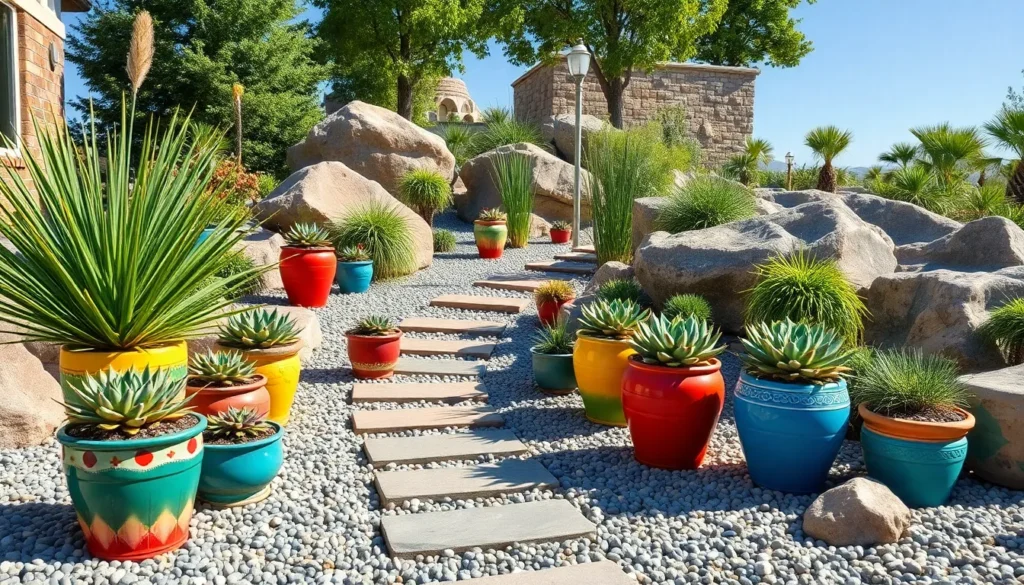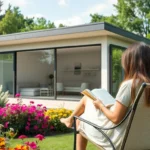Gravel gardens offer the perfect solution for creating stunning low-maintenance landscapes that thrive in any climate. When we combine the natural beauty of decorative stones with strategically placed containers, we unlock endless possibilities for transforming outdoor spaces into captivating garden retreats.
We’ve discovered that incorporating pots into gravel garden designs creates ever-changing visual interest while solving common gardening challenges like poor soil drainage and limited growing space. This versatile approach allows us to experiment with different plant combinations, heights, and seasonal displays without committing to permanent plantings.
Whether you’re working with a small patio, expansive backyard, or challenging terrain, gravel garden designs with container elements deliver maximum impact with minimal upkeep. We’ll explore creative layouts, plant selections, and design principles that’ll help you create a garden that’s both beautiful and practically maintenance-free.
Choose the Right Containers for Your Gravel Garden
Selecting appropriate containers forms the foundation of successful gravel garden pot arrangements. We’ll explore essential factors that determine container performance in gravel settings.
Select Drainage-Friendly Pots
Drainage holes prevent waterlogged soil conditions that damage plant roots in gravel gardens. We recommend containers with multiple drainage openings rather than single central holes for optimal water flow.
Terra cotta pots naturally wick moisture through their porous walls, making them excellent choices for drought tolerant plants. Plastic containers with pre-drilled holes work well for moisture loving species like ferns and hostas.
Elevated pot feet improve drainage by creating air circulation beneath containers. We suggest adding pot risers or decorative stones under containers without built-in elevation features.
Consider Size and Proportion
Large containers create dramatic focal points when positioned strategically throughout gravel landscapes. We recommend using pots that measure at least 18 inches in diameter for substantial visual impact.
Grouping containers of varying heights adds dimensional interest to flat gravel surfaces. Tall cylindrical pots work beautifully alongside wide shallow bowls to create ever-changing arrangements.
Scale your container sizes to match your gravel garden’s overall dimensions. We find that oversized pots can overwhelm small spaces while tiny containers get lost in expansive gravel areas.
Pick Weather-Resistant Materials
Fiberglass containers withstand extreme temperature fluctuations without cracking or fading. We prefer lightweight fiberglass options for their durability and ease of repositioning throughout seasons.
Natural stone planters complement gravel textures while providing excellent insulation for plant roots. Concrete containers offer similar benefits with more affordable pricing and diverse shape options.
Metal containers require careful consideration of heat absorption in sunny locations. We recommend powder coated steel or aluminum pots that resist rust while reflecting excess heat away from plant roots.
Create Multi-Level Displays with Varied Pot Heights
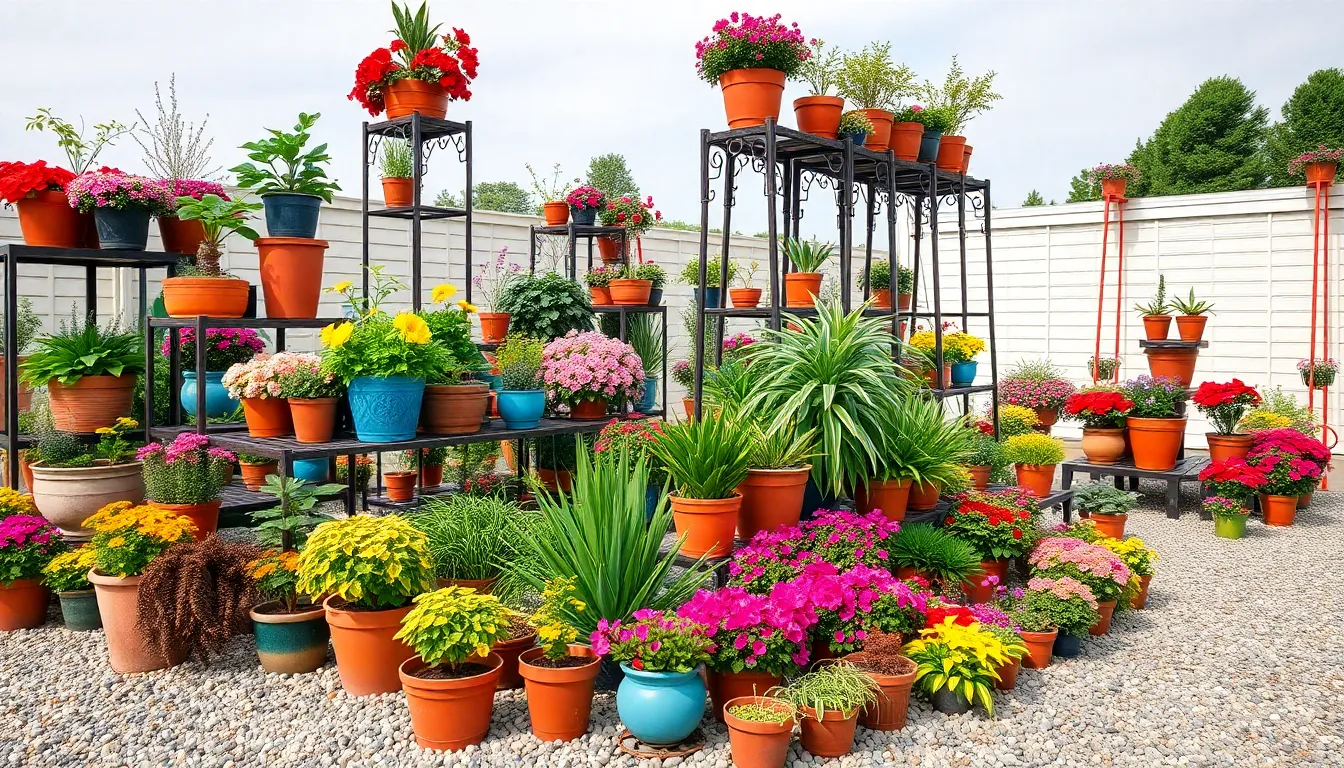
Multi-level displays transform flat gravel garden spaces into ever-changing visual experiences. We’ll explore three proven techniques that add dimension and interest to your container arrangements.
Stack Containers for Vertical Interest
Stacking containers creates impressive vertical gardens even in the smallest spaces. We recommend starting with large, stable pots as your foundation and placing progressively smaller containers on top. This technique works particularly well on compact patios or balconies where ground space is limited.
Choose containers with flat bottoms for the upper levels to ensure stability. We suggest using lightweight materials like fiberglass or plastic for stacked arrangements to prevent excessive weight on lower containers. Make sure each stacked pot has adequate drainage to prevent water from pooling and damaging plants below.
Position your tallest stacked arrangements toward the back of your gravel garden to avoid blocking shorter plants. We find that three-tier stacks create the most balanced visual impact without appearing overwhelming.
Use Plant Stands and Pedestals
Plant stands and pedestals elevate your containers above the gravel surface for enhanced visibility. We recommend using stands of varying heights to create natural-looking elevation changes throughout your garden space. Metal plant stands work exceptionally well in gravel gardens because they complement the modern aesthetic while providing excellent stability.
Wooden pedestals offer a more natural appearance and can be weatherproofed to withstand outdoor conditions. We suggest choosing stands that are slightly smaller in diameter than your pot bases to maintain the illusion that containers are floating above the gravel.
Consider using inverted empty pots as improvised pedestals for budget-friendly elevation answers. This approach allows you to experiment with different heights before investing in permanent stand structures.
Arrange Pots in Graduated Clusters
Graduated clusters create cohesive groupings that draw the eye naturally through your gravel garden. We position our largest containers at the back of each cluster and arrange progressively smaller pots toward the front. This technique mimics natural plant growth patterns and creates depth in your garden design.
Group odd numbers of containers together, as clusters of three or five appear more natural than even-numbered arrangements. We recommend maintaining consistent spacing between pots within each cluster while varying the distances between different clusters throughout your gravel garden.
Choose containers within each cluster that share similar colors or materials to maintain visual unity. We find that mixing different sizes of the same pot style creates the most professional-looking graduated displays while maintaining design coherence across your entire gravel garden space.
Select Drought-Tolerant Plants Perfect for Gravel Gardens
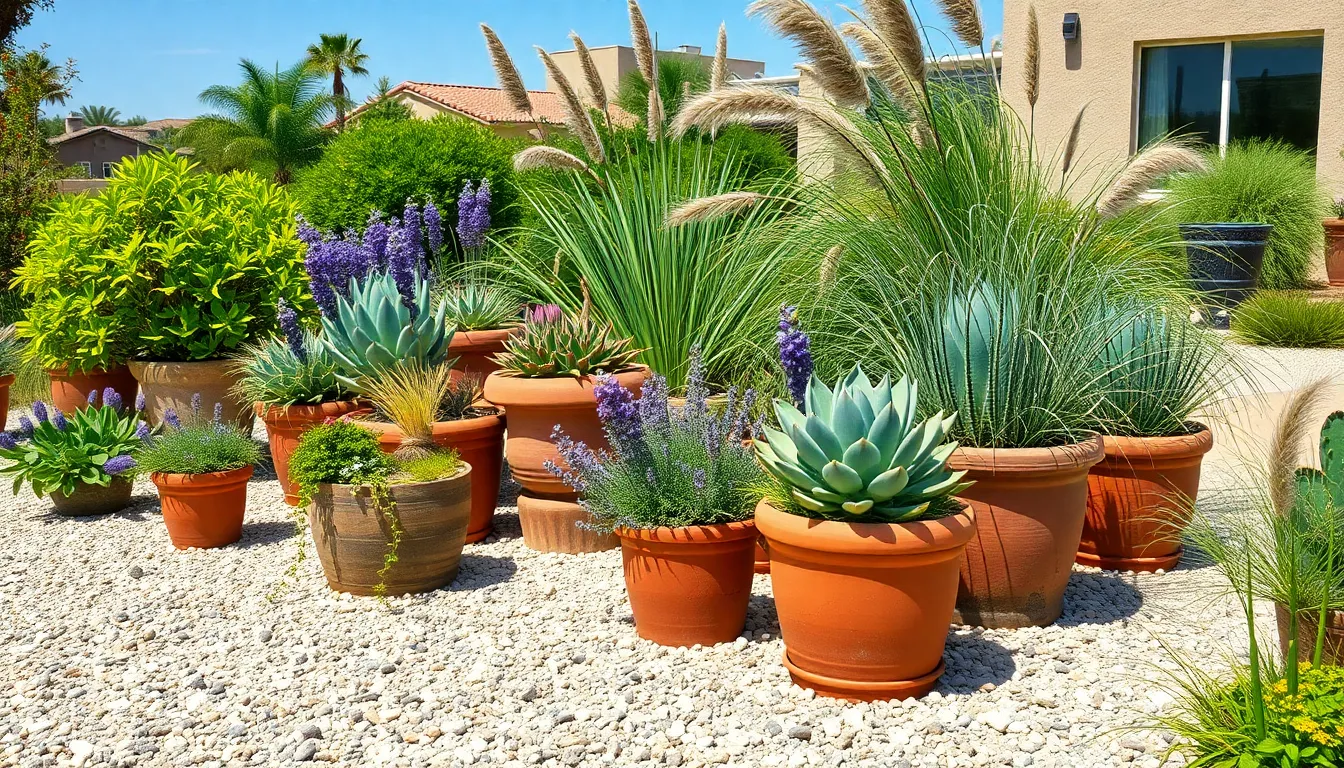
Choosing plants that naturally thrive in dry conditions ensures our gravel garden containers require minimal watering while maintaining stunning visual appeal year-round.
Incorporate Succulents and Cacti
Succulents flourish in gravel gardens because they naturally require well-drained soil and minimal water maintenance. We recommend houseleeks (Sempervivum) as they create remarkable texture contrasts while thriving in pots set directly within gravel beds. Small alpine varieties offer excellent focal points that draw attention throughout the garden design.
Creating mounds in containers with these drought-resistant plants mimics natural mountainous terrain while promoting healthy root development. Cacti varieties add architectural interest to our arrangements, especially when paired with slate chips that enhance their dramatic silhouettes. These low-maintenance plants become conversation starters while reducing our garden’s water consumption significantly.
Add Mediterranean Herbs
Mediterranean herbs transform our gravel garden pots into functional and aromatic displays that thrive in dry conditions. Lavender, rosemary, thyme, and sage naturally tolerate drought while providing year-round fragrance and culinary benefits. Growing these herbs in containers allows us to easily manage their placement and harvest fresh ingredients throughout the growing season.
These aromatic plants enhance the Mediterranean atmosphere of our gravel garden design while requiring minimal water once established. Rosemary creates stunning evergreen structure in larger pots, while thyme cascades beautifully over container edges. We can position these herb-filled containers near seating areas to maximize their sensory impact during outdoor gatherings.
Include Ornamental Grasses
Ornamental grasses bring movement and softness to the hardscape elements of our gravel garden containers. Blue fescue and feather grass naturally thrive in free-draining soils while adding ever-changing texture that changes with seasonal breezes. These drought-tolerant varieties complement both the gravel backdrop and our container arrangements visually.
Feather grasses create dramatic height variations when planted in taller pots, while blue fescue provides compact, silvery accents in smaller containers. We can use these grasses to bridge the visual gap between hard gravel surfaces and more structured plantings. Their natural resilience means less maintenance while delivering maximum impact throughout multiple growing seasons.
Design Pathways Through Your Potted Gravel Garden
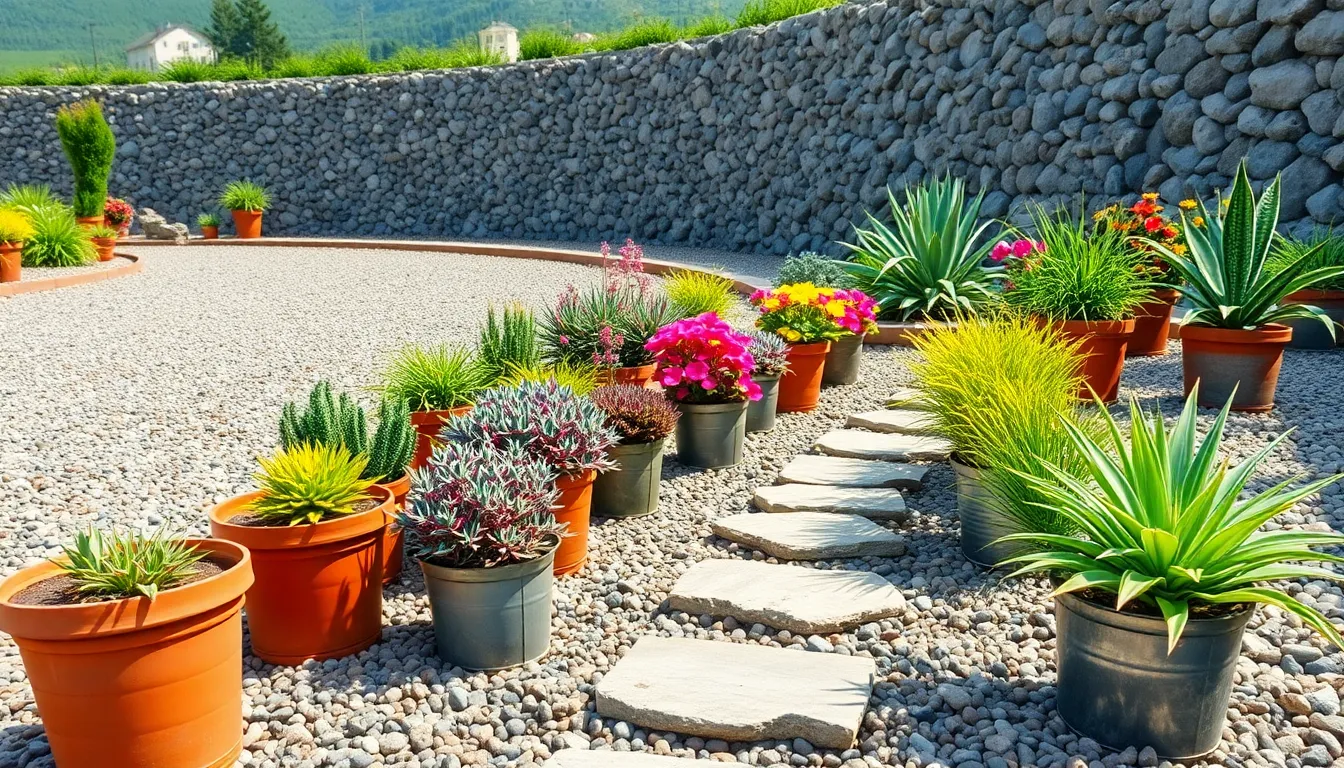
Strategic pathway design transforms your gravel garden from a simple plant display into a functional outdoor space that guides visitors through your carefully arranged containers.
Create Stepping Stone Routes
Stepping stones offer an elegant solution for handling through your potted gravel garden while adding textural contrast. Natural stone pavers work exceptionally well when placed at 18-24 inch intervals along your desired route. Geometric arrangements create a modern, structured feel that complements contemporary container designs. Flowing, curved patterns better suit informal garden styles where you want movement to feel organic and relaxed.
Position stepping stones strategically to highlight your most impressive container displays. We recommend placing stones slightly off-center from large pots to create visual tension and encourage visitors to pause and appreciate exact plantings. This technique works particularly well when showcasing bonsai trees or sculptural succulents that deserve closer inspection.
Consider the practical benefits stepping stones provide beyond aesthetics. They prevent soil compaction around your containers and offer stable footing during watering or maintenance tasks. Stone materials like flagstone or concrete pavers handle weather extremes better than gravel alone, ensuring your pathways remain accessible year-round.
Use Different Gravel Textures for Visual Interest
Mixing gravel colors and sizes creates depth that makes your garden appear larger and more sophisticated. Light-colored gravels like crushed limestone or white marble chips reflect sunlight and create bright backdrops that make plant colors pop. Darker materials such as lava rock or charcoal gravel provide dramatic contrast and work especially well around containers with silver or blue-toned foliage.
Layer different gravel sizes to achieve professional-looking results. Start with larger stones (1-2 inches) as your base layer for stability and drainage. Medium gravel (½-1 inch) fills gaps and creates the primary visual surface. Fine gravel or decomposed granite serves as a top dressing that unifies the overall appearance.
Match gravel colors to your container materials for cohesive design themes. Terra cotta pots pair beautifully with warm-toned gravels like red lava rock or sandstone chips. Neutral containers in gray or black look striking against white or cream-colored stones. This coordination creates a calming backdrop that lets your plants become the main attraction.
Define Borders with Larger Containers
Large containers serve as natural boundary markers that organize your gravel garden into distinct zones. Raised planters measuring 18 inches or taller create effective barriers while providing improved growing conditions for your plants. These elevated borders also make maintenance easier by reducing the need to bend or kneel during planting and weeding tasks.
Strategic placement of oversized pots helps control foot traffic through your garden. Position substantial containers at pathway intersections to naturally guide visitors in preferred directions. This technique prevents people from walking through delicate planting areas while maintaining an open, welcoming feel throughout the space.
Choose container materials that complement your gravel selection for maximum visual impact. Fiberglass planters in neutral tones work with virtually any gravel color and provide excellent durability. Natural stone containers create seamless transitions between planted areas and gravel surfaces. Metal options like corten steel develop attractive patinas that add character as they age in outdoor conditions.
Incorporate Color Schemes That Complement Gravel Tones
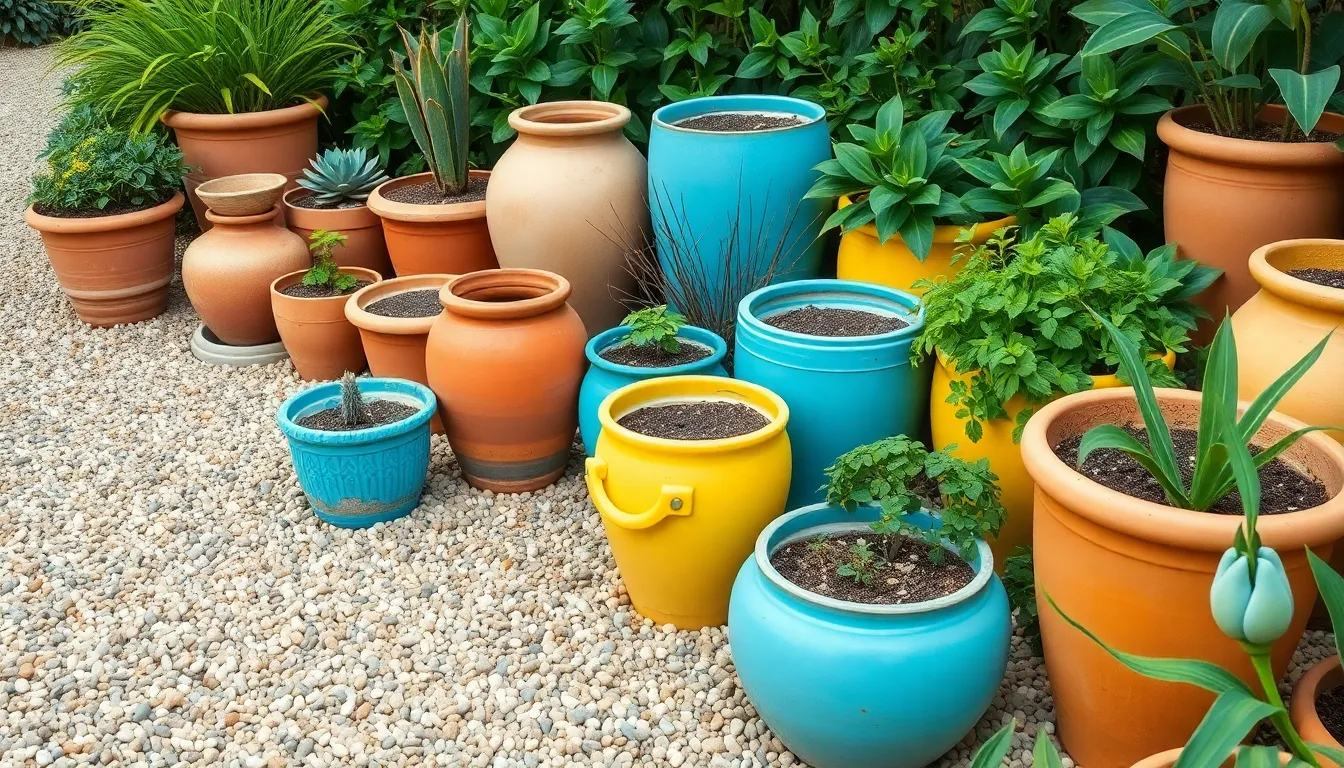
Creating the perfect color palette for your gravel garden enhances the overall visual appeal while maintaining a cohesive design aesthetic.
Match Earth-Toned Pots to Natural Gravel
Earth-toned containers provide the foundation for a harmonious gravel garden design. Terra cotta, weathered bronze, and warm taupe pots blend seamlessly with natural gravel tones, creating a calming backdrop that lets your plants take center stage. We recommend selecting containers in shades of brown, tan, or muted copper to complement gray or beige gravel surfaces.
These neutral tones work exceptionally well with drought-tolerant plants like succulents and Mediterranean herbs. Stone-colored pots enhance the natural texture of gravel while providing visual continuity throughout your garden space. Clay and ceramic containers in earthy hues offer versatility, allowing you to experiment with different plant combinations without clashing with your gravel base.
Add Pops of Color with Bright Containers
Vibrant containers transform gravel gardens from subtle to spectacular with strategic color placement. Bright turquoise, coral, or sunny yellow pots create cheerful focal points against plain gravel backgrounds, adding dimension and visual interest to your outdoor space. We suggest using colorful containers sparingly to maintain balance while creating dramatic impact.
Consider grouping three bright containers in varying sizes to establish compelling visual triangles throughout your garden. Emerald green or cobalt blue pots work particularly well with ornamental grasses and flowering annuals like California poppy or verbena. These bold color choices help define exact garden zones while drawing the eye to your most prized plant specimens.
Create Monochromatic Themes
Monochromatic color schemes offer sophisticated elegance in gravel garden designs. Selecting containers and plants within a single color family creates visual harmony while emphasizing texture and form over bold contrasts. We recommend choosing varying shades of one color, such as different blues from powder to navy, to add depth without overwhelming the space.
Gray containers in multiple tones work beautifully with silver-leafed plants and blue-green succulents, creating a cohesive monochromatic palette. White and cream pots provide another excellent monochromatic option, especially when paired with pale gravel and plants featuring silvery or white-edged foliage. This unified approach creates a zen-like atmosphere that feels both modern and timeless.
Add Structural Elements to Enhance Your Design
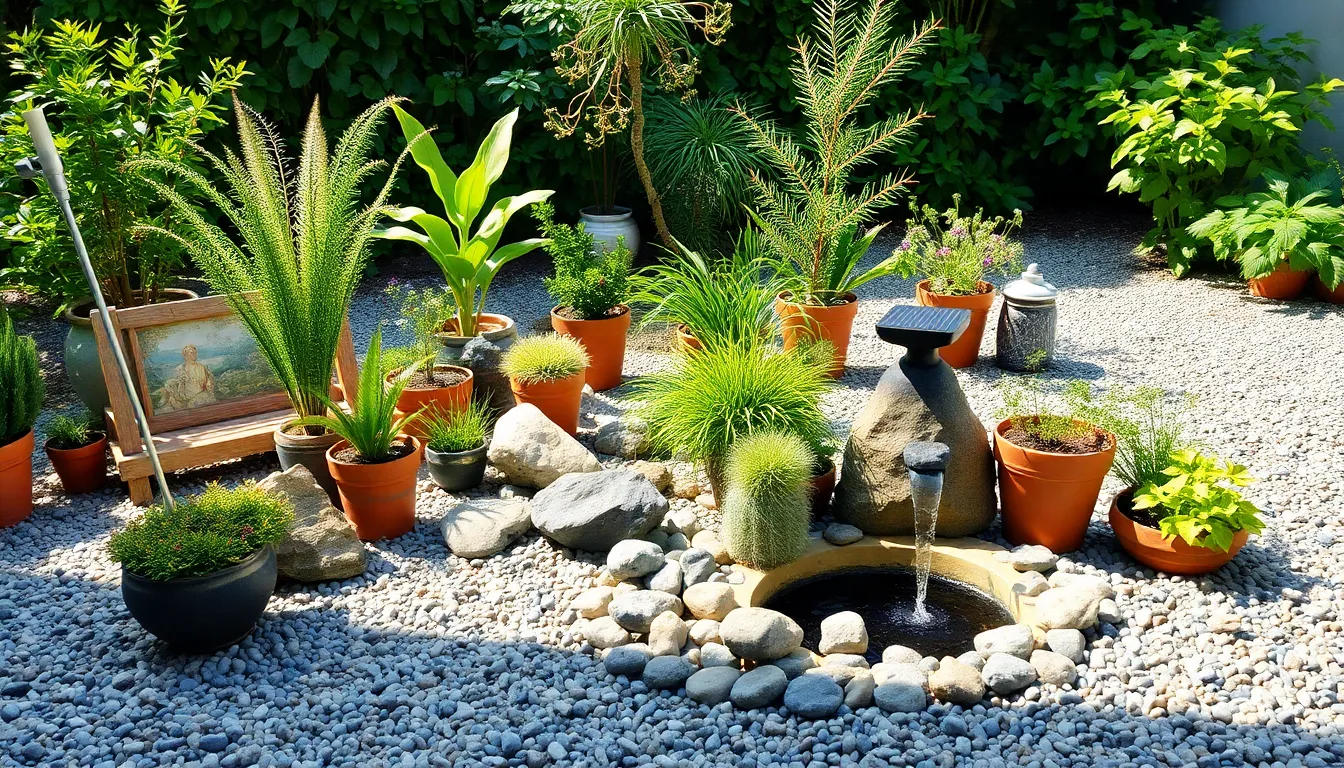
Structural elements serve as the backbone of successful gravel garden designs, creating visual anchors that transform ordinary spaces into sophisticated landscapes. We’ll explore three key additions that elevate your gravel garden from simple to stunning.
Include Decorative Rocks and Boulders
Decorative rocks and boulders enhance the aesthetic appeal of gravel gardens by creating natural focal points around potted displays. We recommend positioning larger boulders strategically near container groupings to establish visual weight and balance throughout your design.
Natural stone selections work best when they complement your existing gravel colors and textures. Large weathered rocks create rustic charm, while smooth river stones offer contemporary appeal. We suggest clustering three to five rocks of varying sizes to achieve organic arrangements that mimic natural landscapes.
Boulder placement requires careful consideration of scale and proportion with your containers. Position the largest stones first to anchor your design, then fill in with medium sized rocks to create transitional elements. Small decorative stones scattered between pots help unify the overall composition while maintaining visual flow.
Integrate Garden Sculptures
Garden sculptures serve as focal points that add personality and visual interest to gravel garden spaces. We’ve found that abstract metal pieces work particularly well against the neutral backdrop of gravel, creating striking contrasts that draw the eye.
Artistic elements should complement rather than compete with your planted containers. Choose sculptures that reflect your personal style while maintaining harmony with the natural surroundings. Contemporary pieces in weathered steel or copper develop beautiful patinas over time, while classical stone sculptures provide timeless elegance.
Strategic placement ensures maximum impact from your sculptural investments. We recommend positioning larger pieces at the ends of sight lines or where pathways intersect to create natural stopping points. Smaller sculptures work well nestled among container groupings, adding surprise elements that reward closer inspection.
Install Simple Water Features
Simple water features like mini fountains and small ponds add tranquility and visual appeal to gravel garden designs. We’ve discovered that the sound of moving water creates a peaceful atmosphere while attracting beneficial wildlife to your outdoor space.
Small self contained fountains require minimal installation and maintenance compared to traditional pond systems. Solar powered options eliminate electrical requirements, making them perfect for remote garden areas. We suggest choosing features with natural stone or weathered metal finishes that blend seamlessly with your gravel and container selections.
Water placement considerations include proximity to seating areas and container groupings where you’ll appreciate the calming effects most. Position features where they’re visible from multiple vantage points to maximize their impact throughout your garden. Remember that water elements work best when they feel integrated rather than added as afterthoughts to your overall design scheme.
Maintain Your Gravel Garden Pots Throughout the Seasons
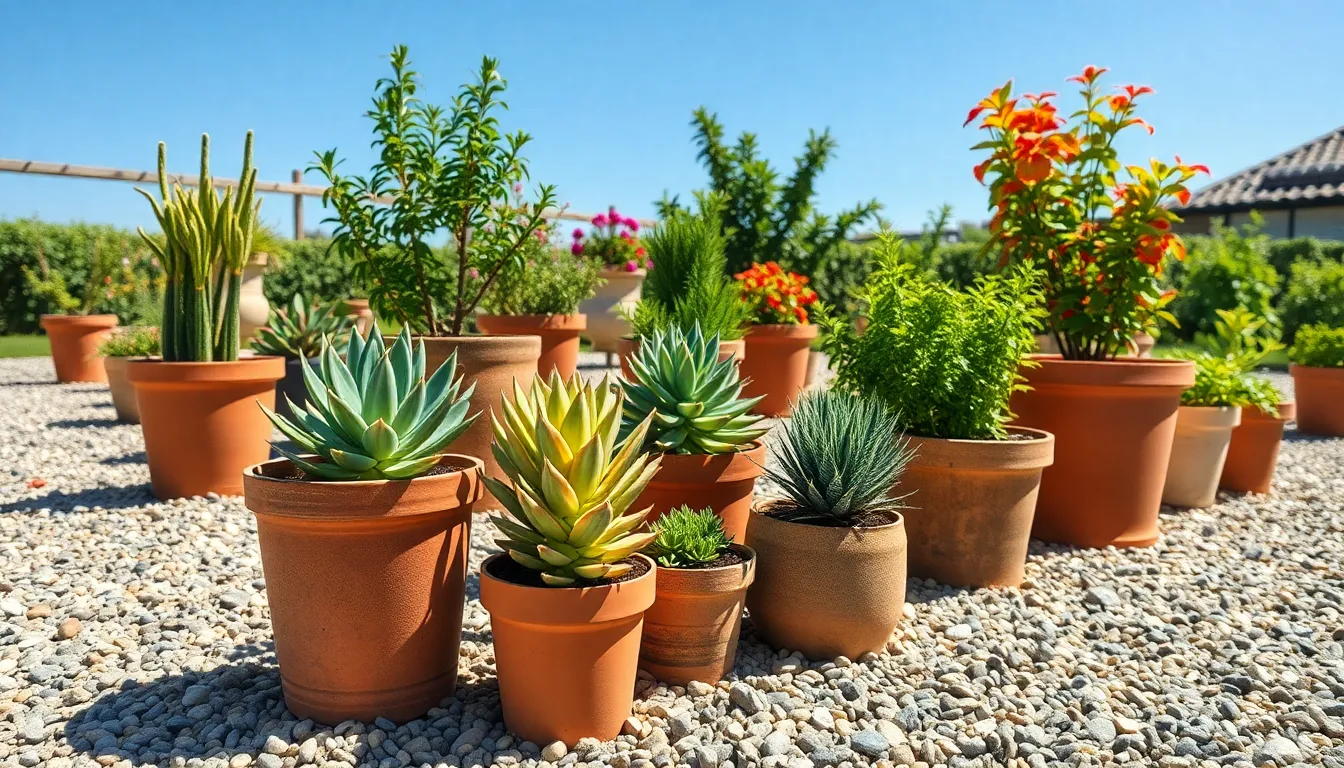
Seasonal maintenance keeps our gravel garden containers healthy and visually appealing year-round. We’ll need to rotate and clean pots regularly while inspecting for damage before winter arrives.
Establish Proper Watering Schedules
Watering needs change dramatically based on plant type and current season. Succulents and drought-tolerant plants require less frequent watering, so we should check soil moisture levels before adding water to prevent overwatering issues. Drip irrigation systems or self-watering containers provide consistent moisture without our constant attention.
Summer months demand increased watering frequency as temperatures rise and evaporation accelerates. We’ll reduce watering during winter when plant growth slows and moisture evaporates less quickly. Mediterranean herbs like lavender and rosemary need deeper but less frequent watering sessions compared to moisture-loving annuals.
Monitoring soil conditions becomes crucial during extreme weather events. We can stick our finger two inches into the soil to test moisture levels before deciding whether plants need water. Container plants dry out faster than ground plantings, making regular checks essential for plant health.
Manage Weed Growth in Gravel Areas
Quality industry fabric beneath our gravel creates an effective barrier against weed emergence. We should inspect gravel areas regularly and remove young weeds before they establish strong root systems or spread throughout the garden.
Annual gravel top-ups discourage weed germination by maintaining proper depth and coverage. Hand-pulling remains the most effective method for removing persistent weeds, ensuring we extract complete root systems to prevent regrowth. Persistent weeds often indicate areas where industry fabric has shifted or deteriorated.
Regular maintenance prevents small weed problems from becoming major landscaping headaches. We’ll focus our attention on edges and corners where wind-blown seeds commonly settle and germinate. Weekly inspections during growing season help us catch problems early.
Protect Plants During Extreme Weather
Frost protection requires moving sensitive containers to sheltered locations or covering them with specialized frost cloth. We should group cold-sensitive pots together indoors or in protected areas when extreme cold threatens plant survival.
Heatwave management involves providing temporary shade and increasing watering frequency as needed. Summer sun can scorch even drought-tolerant plants, so we’ll use shade cloths or temporary screens during peak heat periods. Heavy rain and strong winds pose tipping risks for tall containers, requiring us to secure or relocate vulnerable pots.
Post-weather inspections help us identify pest problems and disease issues that often emerge after stressful conditions. We’ll examine plants for damage, wilting, or unusual discoloration that might indicate underlying problems requiring immediate intervention.
Conclusion
We’ve shown you how gravel gardens with pots offer the perfect blend of beauty and practicality for modern landscaping. This versatile approach transforms any space into a stunning low-maintenance oasis that adapts to your changing needs and preferences.
From selecting the right containers and drought-tolerant plants to designing multi-level displays and seasonal color schemes we’ve covered everything you need to create your own gravel garden masterpiece. The combination of decorative stones strategic pot placement and thoughtful plant selection delivers maximum visual impact with minimal effort.
Whether you’re dealing with poor soil conditions limited space or simply want a garden that won’t demand constant attention these ideas provide the foundation for success. Start small experiment with different arrangements and watch as your gravel garden becomes the envy of your neighborhood.
Frequently Asked Questions
What are the main benefits of gravel gardens?
Gravel gardens offer low-maintenance landscaping that works in various climates. They solve common problems like poor soil drainage and limited space while providing visual interest through decorative stones and strategically placed containers. This versatile approach allows experimentation with different plants and designs without permanent commitments.
What type of containers work best for gravel gardens?
Choose drainage-friendly pots with multiple openings to prevent waterlogging. Terra cotta works well for drought-tolerant plants, while plastic suits moisture-loving species. Use large containers for visual impact and varied heights for dimension. Weather-resistant materials like fiberglass, natural stone, or metal are recommended for durability.
Which plants thrive best in gravel garden containers?
Drought-tolerant plants work exceptionally well, requiring minimal watering. Succulents and cacti like houseleeks create architectural interest. Mediterranean herbs such as lavender, rosemary, thyme, and sage provide fragrance and culinary benefits. Ornamental grasses like blue fescue and feather grass add movement and softness to the design.
How can I create visual interest in my gravel garden?
Create multi-level displays by stacking containers, using plant stands, and arranging pots in graduated clusters. Mix different gravel textures and colors for depth. Use stepping stones as pathways and strategically place large containers to define borders. Add structural elements like decorative rocks, sculptures, or simple water features.
What color schemes work best with gravel gardens?
Earth-toned pots create harmonious designs that complement gravel naturally. Use vibrant containers sparingly to add focal points and pops of color. Consider monochromatic themes within a single color family for sophisticated looks that emphasize texture and form while maintaining visual harmony throughout the space.
How much maintenance do gravel gardens require?
Gravel gardens are low-maintenance but need regular attention. Rotate and clean containers seasonally, inspect for damage, and manage watering schedules based on plant types. Use quality fabric beneath gravel to prevent weeds, conduct regular inspections, and protect plants during extreme weather. Post-weather checks help identify pest issues early.

